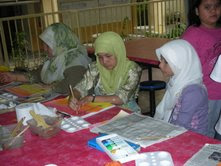Art & about: Turkey takes own art path
2010/04/17
LUCIEN DE GUISE
While the rest of the Middle East have occasional references to Islamic culture, it’s a rare sight in Turkish art
DESPITE the Asian art market making a shaky recovery, collectors are always looking for the next new thing. Should they look East or West? A lot of them are getting both in one reasonably priced package. Turkey is the field of the moment. Turkish contemporary art has been getting more attention in the past year than it has for decades. It may not have caught on as vigorously as Iran, its great rival in Western Asia, but while Iranian art is old news, Turkey has the merit of obscurity. Turkish artists were even left out of the pioneering exhibition, Word into Art, held at the British Museum in 2006. With the subtitle, Artists Of The Modern Middle East, Turkey’s role might have been expected to be greater than that of Tunisia, Sudan or Japan. But this was not the case as none of the 80-plus artists were from Turkey. This was not entirely unexpected as the emphasis was on the written word in Arabic script. While almost every corner of the Islamic art world is working diligently in this field, Turkey seems to have excluded it from its contemporary art. What Turkey does best is art divorced from religion. The exhibition, Without Boundary, at New York’s Museum of Modern Art, also in 2006, did include an important Turkish artist, Kutlug Ataman. It also had a suitably outlandish entry from novelist Orhan Pamuk. His two-page essay starts with “Hi! Thank you for reading me...” and ends with “...you still don’t understand me but already you’re casting me aside”. Pamuk may be right about the failure to understand, but there’s no question of Turkish art being cast aside. What a happy coincidence that Turkey’s most famous author is also an outspoken advocate of the visual arts. He came up with an impressive novel on traditional Ottoman art (My Name is Red) while creating extraordinary intros to contemporary art shows. All that’s needed now is for a major exhibition to promote the brand. So far, Nigella’s husband, Charles Saatchi, has resisted anything more than a superficial involvement, despite his family name being of Turkish origin. Identity is what collectors want to see in new marginal art markets. Where would China be without its Mao imagery? Or Iran without its rich history and monochromatic chadors? Turkey turns out to be a blank canvas. Its curious geographical placing between East and West makes it a grey area in terms of influences, albeit with lots of actual colour. But just as the Ottoman empire looked west for centuries, modern Turks are doing much the same. If entry into the European Union depended on artistic harmony with Europe, the EU welcome mat would have been presented to Turkey long ago. The most conspicuous feature of contemporary Turkish art is its secular nature. While the rest of the Middle East have occasional references to Islamic culture, it’s a rare sight in Turkish art. Although the veil is as big an issue in Turkey as it is in Iran, the latter has made an entire genre out of it. Turkey has taken its own path, and it’s one that might chill state interventionists. This is a country that has grown from having a handful of art galleries to a couple of hundred in a short time.
It is noticeable how little interest has come from the government. The private sector accounts for almost the entire art patronage of Turkey. Banks especially have also been highly supportive. Most of the best museums and galleries are private foundations.
The other force pushing Turkey into the world arena is Sotheby’s. The second of its ground-breaking sales took place last week and showed a wider range of material than a year ago. This international presence has given collectors everywhere the chance to see what Turkish art is all about, and it has boosted sales at local auction houses. Earlier this month, a local company in Istanbul sold a painting by Erol Akyavas, one of the top Turkish artists, for a record price of 1.2 million euros. The majority of works sold at these auctions are in the RM100,000 to RM200,000 band, which a surprising number of collectors feel comfortable with. It makes the field one of the most affordable around, as these prices apply to some of Turkey’s best-known names. In the latest Sotheby’s auctions were some of the dead masters such as the rare female painter Fahrlenissa Zeid whose works go for almost as much as Akyavas’, along with stars of the future such as Taner Ceylan whose painting, 1881, is one of the few contemporary Turkish works to use the fez — a real Ottoman icon that appalled Mustafa Kemal Ataturk. Turkey’s great moderniser would be more pleased to find that Istanbul is this year’s European Capital of Culture and that the Istanbul Biennale is growing in importance. Perhaps the only deterrent to Turkey assuming its rightful place as a Western art centre is the romanisation of the language that Ataturk introduced in 1928. This is still so awkward for non-Turkish speakers — and printers — that it is completely ignored in English-language catalogues.
Sunday, April 18, 2010
Mastermind behind art shows
Mastermind behind art shows
2010/04/17
RACHEL JENAGARATNAM
Shooshie Sulaiman tells RACHEL JENAGARATNAM about her multi-faceted role in the art scene
IF you had to define the word “curator” in a quiz show, would you opt to “phone a friend”, “ask the audience” or answer the question yourself? After all, it’s a relatively unknown job and very few people know just how important a curator is in the art world.
Major art institutions and galleries are incomplete without curators whose task is to create shows that raise their profile and draw audiences in.
Shooshie Sulaiman, an artist-curator and gallery director of 12, explains: “The curator is the mastermind behind the exhibition. The curator handles promotion, operations, management and does the writing. The curator directs the entire show.” But in this country, Shooshie feels that the curator’s responsibilities have been reduced to just writing tasks. “To me, the job involves many things. You can release a one-page statement for an art exhibition, but there are so many other things involved.
“The budget, for example. Oh, the budget!” she says, laughing. As gallery director, Shooshie has balanced a spreadsheet or two, having curated a number of unorthodox exhibitions that challenge the norm among art galleries in the city.
Priority is placed on the message behind each exhibition, ample documentation and unconventional displays that give audiences the ultimate benefit of learning from the artworks.
Notable exhibitions she has curated include Ahmad Fuad Osman’s Dislocated, Puah Chin Kok’s Art as Photography as Art, and 12’s Archive series, which has seen her and her team excavate and document the life and works of artists with a zeal and effort that archaeologists would be proud of.
Recently, she has extended her role as a curator into other areas, notably managing the private art collection of Aliya and Farouk Khan (AFK).
“My team and I were initially asked to create an inventory for the collection. Then I proposed a few other stages. Photo documentation is first and we also plan to research each individual artwork, but it’s a big task,” she explains.
Today, the AFK collection boasts almost 1,000 contemporary homegrown artworks and is arguably the most formidable in the country. The quality and number are enough to rival that of a bona fide institution’s. Last year, the AFK collection bridged the private-public divide with a showcase at the Danga City Mall in Johor Baru. It was shown as part of the Iskandar Malaysia Contemporary Art Show, where Shooshie served as curator.
“Curating that show was really amazing. Never before had an art fair been exhibited that way here,” she says, beaming, referring to the use of vacant shoplots in the mall and the fair’s various fringe programmes that included an artist residency and an art competition that fished out new talents in the growing contemporary art scene.
Puah Chin Kok — Exhibition featuring unique display of photographs
“It was massive, but I liked it because it was challenging,” says Shooshie, an established artist herself.
“Your biggest challenge — as an artist or curator — is to create artwork for the public. In Kuala Lumpur, you still have gallery goers, but in Johor, this isn’t the case!” The AFK collection will be shown again soon together with the launch of a book about the collection’s artists and artworks. Shooshie will once again helm the curatorial duties.
Has it been a tough job managing such an extensive collection? “It’s not difficult, but I consider it a very interesting journey,” says Shooshie, who also speaks highly of the collectors.
“With Farouk, it goes two ways and I really enjoy the discourse we have. We learn from each other.” Matching levels of enthusiasm between the collector and the curator is the key in their relationship.
“Farouk would travel to Kelantan and stay there for 10 hours to be with an unknown artist and then travel back to KL. I like this obsession. It matches my own passion,” says Shooshie.
She and her team — Fatina Alfis and Farah Alwani — have been around long enough to see the collection grow.
“Farouk’s collection started with two-dimensional works, but he’s moved into other mediums such as installations and drawings,” she says, adding that this lends another fascinating dimension to the AFK collection.
For Shooshie, the personal gains of being a curator are obvious. She says it is the perfect balance to her fine art practice.
“The best experience for an artist is to create something, be it an exhibition or artwork,” she sums up.
Still confused about what a curator does? Well, if you are ever in the hot seat in a quiz show, you know who to call.
2010/04/17
RACHEL JENAGARATNAM
Shooshie Sulaiman tells RACHEL JENAGARATNAM about her multi-faceted role in the art scene
IF you had to define the word “curator” in a quiz show, would you opt to “phone a friend”, “ask the audience” or answer the question yourself? After all, it’s a relatively unknown job and very few people know just how important a curator is in the art world.
Major art institutions and galleries are incomplete without curators whose task is to create shows that raise their profile and draw audiences in.
Shooshie Sulaiman, an artist-curator and gallery director of 12, explains: “The curator is the mastermind behind the exhibition. The curator handles promotion, operations, management and does the writing. The curator directs the entire show.” But in this country, Shooshie feels that the curator’s responsibilities have been reduced to just writing tasks. “To me, the job involves many things. You can release a one-page statement for an art exhibition, but there are so many other things involved.
“The budget, for example. Oh, the budget!” she says, laughing. As gallery director, Shooshie has balanced a spreadsheet or two, having curated a number of unorthodox exhibitions that challenge the norm among art galleries in the city.
Priority is placed on the message behind each exhibition, ample documentation and unconventional displays that give audiences the ultimate benefit of learning from the artworks.
Notable exhibitions she has curated include Ahmad Fuad Osman’s Dislocated, Puah Chin Kok’s Art as Photography as Art, and 12’s Archive series, which has seen her and her team excavate and document the life and works of artists with a zeal and effort that archaeologists would be proud of.
Recently, she has extended her role as a curator into other areas, notably managing the private art collection of Aliya and Farouk Khan (AFK).
“My team and I were initially asked to create an inventory for the collection. Then I proposed a few other stages. Photo documentation is first and we also plan to research each individual artwork, but it’s a big task,” she explains.
Today, the AFK collection boasts almost 1,000 contemporary homegrown artworks and is arguably the most formidable in the country. The quality and number are enough to rival that of a bona fide institution’s. Last year, the AFK collection bridged the private-public divide with a showcase at the Danga City Mall in Johor Baru. It was shown as part of the Iskandar Malaysia Contemporary Art Show, where Shooshie served as curator.
“Curating that show was really amazing. Never before had an art fair been exhibited that way here,” she says, beaming, referring to the use of vacant shoplots in the mall and the fair’s various fringe programmes that included an artist residency and an art competition that fished out new talents in the growing contemporary art scene.
Puah Chin Kok — Exhibition featuring unique display of photographs
“It was massive, but I liked it because it was challenging,” says Shooshie, an established artist herself.
“Your biggest challenge — as an artist or curator — is to create artwork for the public. In Kuala Lumpur, you still have gallery goers, but in Johor, this isn’t the case!” The AFK collection will be shown again soon together with the launch of a book about the collection’s artists and artworks. Shooshie will once again helm the curatorial duties.
Has it been a tough job managing such an extensive collection? “It’s not difficult, but I consider it a very interesting journey,” says Shooshie, who also speaks highly of the collectors.
“With Farouk, it goes two ways and I really enjoy the discourse we have. We learn from each other.” Matching levels of enthusiasm between the collector and the curator is the key in their relationship.
“Farouk would travel to Kelantan and stay there for 10 hours to be with an unknown artist and then travel back to KL. I like this obsession. It matches my own passion,” says Shooshie.
She and her team — Fatina Alfis and Farah Alwani — have been around long enough to see the collection grow.
“Farouk’s collection started with two-dimensional works, but he’s moved into other mediums such as installations and drawings,” she says, adding that this lends another fascinating dimension to the AFK collection.
For Shooshie, the personal gains of being a curator are obvious. She says it is the perfect balance to her fine art practice.
“The best experience for an artist is to create something, be it an exhibition or artwork,” she sums up.
Still confused about what a curator does? Well, if you are ever in the hot seat in a quiz show, you know who to call.
Embracing matters of art
MAZLINA MOHD NOOR:
Embracing matters of art
2010/04/18
By Mazlina Mohd Noor( mazlinanoor@nst.com.my)
MY first brush with fear occurred in 1987. Like the other little boys and girls in my class, I had to digest all my Year One lessons in a building facing a Chinese cemetery.
We often stared at the tombstones from our classroom window. Sometimes, we even tried to count the number of plots only to lose track through the sound of our own quickening heartbeats.
I had classes in the afternoon, so dad would usually pick me up by 6.15pm, latest. But on one particularly cloudy day, that didn't happen.
Dusk was approaching and my dad's trusty old Civic was nowhere to be seen. Buses and cars zoomed by, leaving only a few kids behind, including me, standing miserably at the porch. There were staff members scattered about, but when you're 7, hungry and in close proximity with the undead, you don't see what you should be seeing any longer.
I felt horrible. My initial feeling was that something terrible had happened to my parents. By 7pm, I had properly lost the will to live. I sobbed uncontrollably while trying hard not to look north. The sky turned yellow and I knew that once darkness took over, evil spirits would come out and grab me.
Suddenly, a familiar sight screeched to a sudden halt. Grinning from ear to ear, mum and dad swiftly packed me into the back seat of our car, completely unaware of how paranoia had almost paralysed their last born. Waving a rabbit-shaped pencil box as a token of apology, Mum rattled on about how they got delayed in traffic. But it was too late. My 7-year-old nerves had been shot to ribbons and I remember not wanting to ever feel that way again.
Yet as life would have it, fear would continue to plague my existence. It would accompany me throughout that ridiculous journey of achieving the idea of perfection that was mostly in my head. This persisted until I came across a painting which affected my perception. It was the inventive work of the eminent Spanish Catalan artist, Salvador Dali.
The Anthropomorphic Cabinet depicts a man burying his head into one of the many drawers attached to him, searching for an explanation of what is happening within.
Shadows of people lurk in the distant, and although the man seems to reach out as if telling them to stop and wait for him, he is still more interested in peering into his chest of drawers.
Dali had cleverly used bizarre imagery to illustrate the secret compartments within human beings and how they spend too much time smelling the odours that emanate from each.
Too often, I have done the exact mistake of focusing on my own inner fears and flaws. I used to draw comparisons with my peers, wondering if I was as smart or as competitive and as talented as them. I feared the unlikely and everything that was beyond my control. I blamed myself for what I thought I lacked, yet never fully addressing it. I was far too intent on being crippled by negativity.
Being self-absorbed in the most excessive manner only promotes a weaker mind and a dangerous sort of self-indulgence. When humans tend to overestimate or underestimate their own value, reality takes a dimmer view.
Dali, in his painting, had dissected this through a looking glass with a language of innocence that floats between genius and madness.
He showed me that being exposed to your deepest fear gives less power to the fear itself. I am no longer so wary of my limitations or take too much pride in my accomplishments, as if the state of my person solely depended on them.
To be too afraid, or conscious, of anything and everything certainly diverts you from what truly matters: the enjoyment of life and appreciating your loved ones.
The way art feeds minds and heals hearts never ceases to amaze me. Absorbing a painting, with its stiff, passionate dignity and moral demands can smash open a person's blocked-off sorrows.
The incredible works of Dali, who had dabbled in almost every artistic medium imaginable, from furniture to sculpture, greatly fascinate me.
He defied all conventions and charged forward with a spirit unmatched by others. The way he painted his dreams and moods in a precise illusionistic fashion produces thunderous revelations about social character.
Dali's brand of surrealism destroys only what it considers to be shackles limiting our vision, and the ideals which it expounds are nothing short of an eye-opener.
Through art, I discovered a new kind of adrenaline rush not found in pure arithmetic or fast cars. I realised that real education lies in the simplest form of aesthetics. It holds the power to change the way one views the world.
The Anthropomorphic Cabinet has reinforced my belief in the importance of being kind to myself and being brave.
As Ernest Hemingway said: "There is nothing noble in being superior to your fellow man. True nobility lies in being superior to your former self."
Embracing matters of art
2010/04/18
By Mazlina Mohd Noor( mazlinanoor@nst.com.my)
MY first brush with fear occurred in 1987. Like the other little boys and girls in my class, I had to digest all my Year One lessons in a building facing a Chinese cemetery.
We often stared at the tombstones from our classroom window. Sometimes, we even tried to count the number of plots only to lose track through the sound of our own quickening heartbeats.
I had classes in the afternoon, so dad would usually pick me up by 6.15pm, latest. But on one particularly cloudy day, that didn't happen.
Dusk was approaching and my dad's trusty old Civic was nowhere to be seen. Buses and cars zoomed by, leaving only a few kids behind, including me, standing miserably at the porch. There were staff members scattered about, but when you're 7, hungry and in close proximity with the undead, you don't see what you should be seeing any longer.
I felt horrible. My initial feeling was that something terrible had happened to my parents. By 7pm, I had properly lost the will to live. I sobbed uncontrollably while trying hard not to look north. The sky turned yellow and I knew that once darkness took over, evil spirits would come out and grab me.
Suddenly, a familiar sight screeched to a sudden halt. Grinning from ear to ear, mum and dad swiftly packed me into the back seat of our car, completely unaware of how paranoia had almost paralysed their last born. Waving a rabbit-shaped pencil box as a token of apology, Mum rattled on about how they got delayed in traffic. But it was too late. My 7-year-old nerves had been shot to ribbons and I remember not wanting to ever feel that way again.
Yet as life would have it, fear would continue to plague my existence. It would accompany me throughout that ridiculous journey of achieving the idea of perfection that was mostly in my head. This persisted until I came across a painting which affected my perception. It was the inventive work of the eminent Spanish Catalan artist, Salvador Dali.
The Anthropomorphic Cabinet depicts a man burying his head into one of the many drawers attached to him, searching for an explanation of what is happening within.
Shadows of people lurk in the distant, and although the man seems to reach out as if telling them to stop and wait for him, he is still more interested in peering into his chest of drawers.
Dali had cleverly used bizarre imagery to illustrate the secret compartments within human beings and how they spend too much time smelling the odours that emanate from each.
Too often, I have done the exact mistake of focusing on my own inner fears and flaws. I used to draw comparisons with my peers, wondering if I was as smart or as competitive and as talented as them. I feared the unlikely and everything that was beyond my control. I blamed myself for what I thought I lacked, yet never fully addressing it. I was far too intent on being crippled by negativity.
Being self-absorbed in the most excessive manner only promotes a weaker mind and a dangerous sort of self-indulgence. When humans tend to overestimate or underestimate their own value, reality takes a dimmer view.
Dali, in his painting, had dissected this through a looking glass with a language of innocence that floats between genius and madness.
He showed me that being exposed to your deepest fear gives less power to the fear itself. I am no longer so wary of my limitations or take too much pride in my accomplishments, as if the state of my person solely depended on them.
To be too afraid, or conscious, of anything and everything certainly diverts you from what truly matters: the enjoyment of life and appreciating your loved ones.
The way art feeds minds and heals hearts never ceases to amaze me. Absorbing a painting, with its stiff, passionate dignity and moral demands can smash open a person's blocked-off sorrows.
The incredible works of Dali, who had dabbled in almost every artistic medium imaginable, from furniture to sculpture, greatly fascinate me.
He defied all conventions and charged forward with a spirit unmatched by others. The way he painted his dreams and moods in a precise illusionistic fashion produces thunderous revelations about social character.
Dali's brand of surrealism destroys only what it considers to be shackles limiting our vision, and the ideals which it expounds are nothing short of an eye-opener.
Through art, I discovered a new kind of adrenaline rush not found in pure arithmetic or fast cars. I realised that real education lies in the simplest form of aesthetics. It holds the power to change the way one views the world.
The Anthropomorphic Cabinet has reinforced my belief in the importance of being kind to myself and being brave.
As Ernest Hemingway said: "There is nothing noble in being superior to your fellow man. True nobility lies in being superior to your former self."
Subscribe to:
Comments (Atom)






















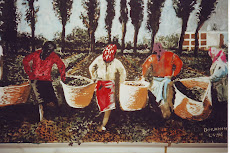

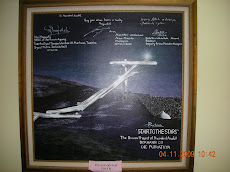





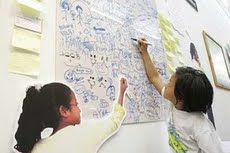

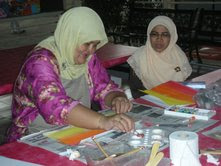.jpg)

